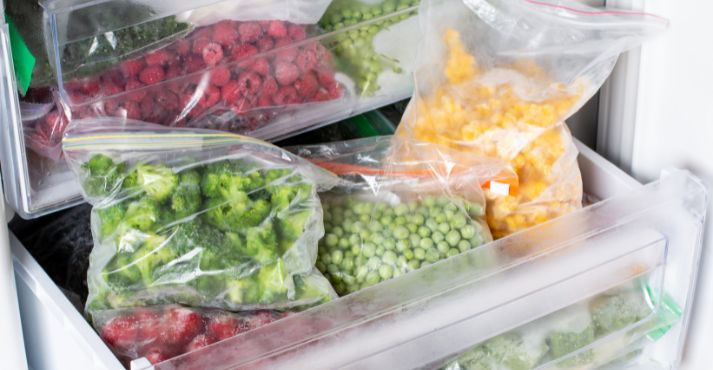Let’s talk about convenience food. It’s the kind of food that’s easy and quick to eat, perfect for our busy lives. Think about those ready-made meals or snacks that you can grab when you’re in a hurry.
Convenience food is like the superhero of our kitchen when time is short. Fast food and ready-to-eat meals fall into this category. They’re the meals that save us when rushing from one thing to the next.
In today’s fast-paced world, we often need food that keeps up with our on-the-go lifestyle. Convenience food is there for those times when cooking from scratch is just not an option.
Convenience food is about making our lives easier in a world in motion. It’s the go-to solution when we need a quick, tasty bite without spending too much time in the kitchen.
Defining Convenience Food

What is Convenience Food?
At its core, convenience food refers to pre-packaged or pre-prepared meals tailored for swift and effortless consumption. These are the go-to options when time is scarce, and the kitchen feels like a distant land.
Ready-Made Efficiency
Picture those meals neatly packed, waiting to be heated or served straight from the packaging. These are the epitome of convenience food – designed to minimize your time in the kitchen while maximizing your enjoyment of a satisfying meal.
Quick, Easy, Delicious
In simple terms, convenience food is your culinary shortcut to a quick, hassle-free, and delicious dining experience. The culinary ally transforms moments of hunger into moments of instant satisfaction.
Types of Convenience Foods: A Variety for Every Occasion
Convenience foods are a big part of our busy lives, offering many choices for different tastes and situations.
1. Frozen Convenience Foods: Easy and Quick
Frozen foods are great for when you want a fast meal without much effort. You can find various options, from single-serve meals to large pizzas. These frozen foods let you spend less time cooking and more time enjoying your meal.
2. Canned Convenience Foods: Instant Kitchen Helpers
Canned goods are like kitchen superheroes. Soups, beans, and veggies sit in your pantry, ready to become a good meal. With a long shelf life of up to 5 years and little prep needed, canned convenience foods are perfect when you want a quick and straightforward meal.
3. Snack Options: Tasty and Quick
Snacking isn’t just about chips anymore, with the latest trends in the snacks industry. Convenience snacks now come in many varieties – from healthy nuts and energy bars to the occasional treat of flavored popcorn. These snacks are perfect for when you get hungry out of the blue, giving you a quick and tasty fix.
Ready-to-Cook and Shelf-Stable: Meeting Your Needs
Convenience foods are about more than fully cooked options. There are also ready-to-cook meals with pre-cut ingredients and easy recipes, making cooking simpler.
And then you have shelf-stable foods that wait patiently on your pantry shelves, staying fresh until you’re ready to use them.
In a nutshell, convenience foods offer many choices, catering to different preferences and lifestyles. From the freezer to the pantry, it’s a world where convenience meets good food.
Evolution of Convenience Food
Understanding convenience foods means traveling back in time to witness their fascinating evolution. Let’s explore how these time-saving delights have become integral to our culinary landscape.
Canned Convenience Foods: A Revolutionary Invention

The journey began with the advent of canned goods. In the early 19th century, the invention of canning transformed food preservation.
Suddenly, fruits, vegetables, and even meats could be stored for extended periods, providing a convenient solution to the challenge of seasonal availability.
The Rise of Ready-to-Eat Meals: Convenience on Demand
As we moved into the mid-20th century, a significant shift occurred. Ready-to-eat meals emerged, offering a quick and hassle-free way to enjoy a variety of dishes.
From TV dinners to microwavable meals, these innovations marked a departure from traditional cooking, catering to the fast-paced lifestyles of the modern era.
Fast Food Revolution: Quick Bites for Busy Lives
The most recognizable face of convenience food is fast food. The latter half of the 20th century saw the rapid growth of the fast-food industry, with iconic chains providing instant gratification to hungry patrons.
Burgers, fries, and sodas became synonymous with quick, tasty, and easily accessible meals.
Impact on Culinary Habits
Convenience foods have significantly shaped modern culinary habits and transformed how we approach cooking and dining. The accessibility and ease of preparing ready-made meals, whether frozen, canned, or snack items, have led to a notable shift in our food culture.
Influence on Culinary Habits:
- Time Efficiency: Convenience foods offer a quick solution for individuals with busy schedules. The time saved in preparation allows people to balance work, family, and other commitments seamlessly.
- Diverse Options: The variety of convenience foods caters to different tastes and preferences. From frozen meals that require minimal cooking to ready-to-eat snacks, individuals have a plethora of options to choose from.
- Changing Eating Patterns: The convenience of these foods has contributed to a shift in eating patterns. Quick and accessible options often lead to more frequent, smaller meals throughout the day than large meals.
- Global Influence: Convenience foods often draw inspiration from various cuisines worldwide. This globalization of flavors has expanded people’s palates and encouraged experimentation in the kitchen.
- Reduced Cooking Stress: Individuals experience less meal planning and cooking stress with ready-made options. This has resulted in a more relaxed approach to preparing meals, fostering a positive relationship with food.
Overall, the impact of convenience foods on culinary habits reflects a dynamic and evolving food culture, adapting to the demands of contemporary lifestyles.
Convenience Food Ingredients
Understanding the processing methods of creating convenience foods provides insight into their nutritional and overall impact. Convenience foods undergo specific procedures in their preparation, influencing their taste, texture, and nutritional value.
Processing Methods
-
- Freezing: Many frozen convenience foods, such as frozen meals or vegetables, undergo freezing as a primary preservation method. Freezing helps maintain the texture and nutritional content of the food while extending its shelf life.
- Canning: Canned convenience foods involve the preservation of food in sealed containers. This process often involves heating to destroy bacteria and sealing the cans to prevent contamination. While it enhances shelf life, it can impact the texture and nutrient content.
- Dehydration: Dehydrating food removes its moisture content, inhibiting the growth of microorganisms. This method is commonly used for dried fruits, instant soups, and other convenience items. However, dehydration can lead to a loss of some heat-sensitive nutrients.
- High-Pressure Processing (HPP): HPP is a food preservation technique that uses high water pressure to eliminate harmful bacteria while maintaining the nutritional quality and flavor of the food. It’s often employed in creating minimally processed, ready-to-eat meals.
- Refrigeration: Some convenience foods, especially perishable items like pre-packaged salads or deli meats, rely on refrigeration to maintain freshness. Controlled temperatures help slow down bacterial growth.
Additives and Preservatives
Food Additives
- Flavor Enhancers: Convenience foods often include additives that enhance taste and aroma. Typical flavor enhancers, such as monosodium glutamate (MSG), contribute to the savory profile of various dishes, providing a more enjoyable culinary experience.
- Colorants: Some convenience foods may contain color additives to maintain a visually appealing appearance. These additives ensure the product’s color consistency, especially in sauces, snacks, or desserts.
- Texturizers: Additives like emulsifiers and stabilizers are employed to improve the texture and consistency of convenience foods. This ensures a pleasing mouthfeel and prevents undesirable changes during storage.
Preservatives in Convenience Food
- Antioxidants: To prevent the oxidation of fats and oils in processed foods, antioxidants like vitamin C and tocopherols are commonly used. These additives help maintain the product’s freshness and prevent rancidity.
- Microbial Inhibitors: Preservatives such as benzoates and sorbates are added to prevent the growth of bacteria, yeast, and molds. They contribute to the extended shelf life of various convenience items.
- Nitrites and Nitrates: Often used in processed meats, these preservatives help prevent the growth of harmful bacteria, enhance color, and contribute to the characteristic flavor of cured products.
Understanding the role of additives and preservatives in convenience foods is essential for consumers who wish to make informed product choices. It provides insight into the purpose of these components and how they contribute to the overall quality and safety of the food.
Convenience Food in Daily Life

Convenience Food Consumption Trends
In the hustle and bustle of modern living, convenience foods have become integral to daily life, shaping how people approach meal preparation and consumption.
Let’s delve into the current trends surrounding the consumption of convenience foods and their prevalence in our everyday routines.
Consumer Trends
- Time Efficiency: With increasingly busy schedules, consumers are seeking quick and convenient meal options. Ready-to-eat and easy-to-prepare convenience foods align with the need for time-efficient solutions catering to individuals and families alike.
- Diverse Dietary Needs: The market for convenience foods has evolved to accommodate various dietary preferences and restrictions. From gluten-free to plant-based options, food manufacturers are addressing the diverse nutritional needs of consumers, providing convenient choices for different lifestyles.
- Health and Wellness Focus: The trend towards healthier living has influenced the development of convenience foods emphasizing nutritional value. Consumers are now more conscious of ingredients, leading to the availability of healthier convenience options that prioritize quality and freshness.
Daily Convenience Food Use
- On-the-Go Snacking: Convenience foods have become synonymous with on-the-go snacking. Single-serving portions of snacks, such as granola bars, yogurt cups, and pre-cut fruits, cater to individuals looking for quick bites during busy moments.
- Microwavable Meals: Ready-to-heat meals designed for microwave convenience offer a quick and simple solution for those with limited time for cooking. These meals span various cuisines and provide diverse options for consumers.
- Meal Kits and Prep Services: The rise of meal kit services combines the convenience of pre-portioned ingredients with the experience of cooking at home. Consumers can enjoy the convenience of a planned meal without compromising on the joy of culinary preparation.
Understanding these trends sheds light on the evolving landscape of convenience food consumption.
While convenience foods offer practical solutions for busy lifestyles, contemporary consumers also seek health-conscious options that align with their nutritional goals.
As convenience shapes our dietary habits, the industry adapts to meet consumers’ needs and preferences.
Health Considerations
In modern living, where convenience often takes center stage, it’s essential to explore the health considerations of frequent consumption of convenience foods.
Balanced Eating Amid Convenience
- Nutritional Concerns: While offering quick solutions, convenience foods may need help providing a well-rounded nutritional profile. Consumers should be mindful of potential nutrient gaps and prioritize foods rich in essential vitamins, minerals, and dietary fibers.
- Processed Ingredients: Many convenience foods undergo extensive processing, sometimes leading to increased added sugars, salt, and unhealthy fats. Maintaining awareness of ingredient lists and opting for minimally processed options can contribute to a more balanced diet.
Maintaining a Healthy Diet
- Portion Control: Convenience foods often come in pre-packaged portions, making it crucial for consumers to be mindful of portion control. Understanding serving sizes helps individuals manage calorie intake and maintain a healthy diet.
- Incorporating Fresh Ingredients: Supplementing convenience meals with fresh, whole ingredients can enhance their nutritional value. Adding vegetables, fruits, and lean proteins can create a more balanced and wholesome eating experience.
- Dietary Variety: Relying solely on convenience foods may limit the diversity of nutrients in one’s diet. Incorporating a variety of food groups, colors, and textures ensures a broader spectrum of essential nutrients, promoting overall health and well-being.
Making Informed Choices:
- Reading Labels: Being mindful of nutritional labels empowers consumers to make informed choices. Paying attention to the nutritional content ingredient list and understanding the impact of additives allows individuals to select options aligned with their health goals.
- Educational Initiatives: Promoting awareness about healthy eating habits and providing educational resources can empower consumers to make choices that contribute to their overall well-being. Encouraging a balanced approach to convenience foods is crucial for sustaining long-term health.
Convenience Food Industry
The convenience food industry has grown significantly, reshaping the culinary landscape and leaving an indelible mark on economic dynamics.
Market Growth in the Convenience Food Industry
Industry Expansion
- Dynamic Market Growth: The convenience food market has witnessed dynamic expansion, driven by evolving consumer lifestyles, increased urbanization, and the demand for quick, ready-to-eat solutions. This growth trajectory underscores the industry’s ability to adapt to changing preferences.
- Diverse Product Offerings: The industry’s growth is underscored by the proliferation of diverse product offerings, ranging from frozen meals and snacks to pre-packaged fresh options. This diversity caters to broad consumer needs, contributing to sustained market expansion.
Economic Influence
- Job Creation: The growth of the convenience food industry has had a notable impact on employment, generating opportunities across various production and supply chain stages. From manufacturing to distribution, the industry plays a role in supporting livelihoods.
- Supply Chain Contribution: Convenience food’s rise has contributed significantly to the economic viability of the supply chain. This includes agriculture, manufacturing, transportation, and retail sectors, fostering a network of interconnected economic activities.
Global Economic Impact
- Trade and Exports: The convenience food industry’s global expansion has increased trade and exports of these products. This cross-border movement stimulates economic activity and fosters international cooperation in the food sector.
- Investment Opportunities: Recognizing the potential for sustained growth, investors have increasingly focused on the convenience food sector. This influx of investments fuels innovation and enhances the industry’s economic significance.
Socioeconomic Implications
- Accessibility and Affordability: The widespread availability of convenient, ready-to-eat options enhances food accessibility and affordability for consumers across various socioeconomic backgrounds.
- Consumer Spending Patterns: The industry’s growth has influenced consumer spending patterns, with more individuals allocating a portion of their budgets to convenient meal solutions. This shift reflects changing preferences and priorities in modern living.
Sustainability Efforts
The convenience food industry is transforming toward sustainability, aligning its practices with eco-conscious principles for a greener future.
Eco-Friendly Packaging

- Reducing Environmental Footprint: A notable stride in sustainability is witnessed through adopting eco-friendly packaging. Companies are increasingly steering away from conventional materials that contribute to environmental degradation. Instead, they embrace biodegradable, compostable, or recyclable options, thus lessening the ecological impact.
- Innovative Packaging Solutions: The industry actively invests in innovative packaging solutions that extend product shelf life without compromising sustainability. From bioplastics to reusable containers, these initiatives benefit the environment and resonate positively with environmentally conscious consumers.
Sustainable Sourcing Practices
- Traceability and Transparency: Recognizing the importance of sustainable sourcing, many convenience food manufacturers prioritize transparency in their supply chains. This involves providing consumers with information about the origin of ingredients, supporting fair trade practices, and ensuring ethical sourcing.
- Local Sourcing Initiatives: To minimize the carbon footprint associated with transportation, the industry is increasingly turning towards locally sourced ingredients. This shift reduces environmental impact, fosters community engagement, and supports local economies.
Corporate Social Responsibility (CSR)
- Community Engagement: Sustainability efforts in the convenience food industry often extend beyond the product itself. Companies are engaging in community-based initiatives, contributing to environmental conservation projects, and promoting awareness about sustainable living practices.
- Energy Efficiency: Embracing energy-efficient practices in manufacturing and distribution is a crucial aspect of sustainability. This includes investments in renewable energy sources and adopting energy-efficient technologies to minimize the ecological impact of operations.
Consumer Awareness and Engagement:
- Educating Consumers: Convenience food brands are taking proactive measures to educate consumers about the environmental impact of their choices. This involves transparent communication about sustainability initiatives and encouraging consumers to make eco-conscious decisions.
- Promoting Responsible Consumption: Sustainability in the convenience food industry is about production practices and fostering responsible consumption. Brands encourage consumers to minimize food waste, recycle packaging, and make choices aligned with ecological well-being.
Conclusion
Convenience foods have become integral to modern lifestyles, offering time-efficient solutions and diverse options.
However, as we savor the convenience, it’s essential to navigate with nutritional awareness. Consumers are increasingly making educated choices, seeking a balance between the ease of ready-to-eat options and health considerations.
The industry, in response, is innovating towards healthier formulations and sustainability. As we conclude, the landscape of convenience foods evolves, shaped by the delicate interplay of consumer choices and industry adaptations.













